A cello sold for £13,800 in Bonhams in 1996. It was made in Glasgow in 1924, and it set the record price for an instrument by its creator, James William Briggs. He was a maker of violins and cellos of some repute, and a resident of Strathbungo.
The cello above is another of his instruments, dated 1927, and (as at May 2023) available for £35,000 .
Briggs (1855-1935) was born in Wakefield, Yorkshire. At the age of 14 he was apprenticed to William Tarr. At 21 Briggs set up his own business in Wakefield, married and had 3 children. Business was slow at this time but he received a gold medal at the Leeds exhibition in 1890, followed by diplomas from Paris & Vienna. In 1893 he moved his business to Glasgow. He had a shop in town, and lived at 12 Queen Square (at that time known as 5 Queen Square) from around 1905 until his death.
His premises were at 99 Cambridge Street, before a move to 122 Sauchiehall Street in 1898, and back to 8 Cambridge Street 1903-1935 .
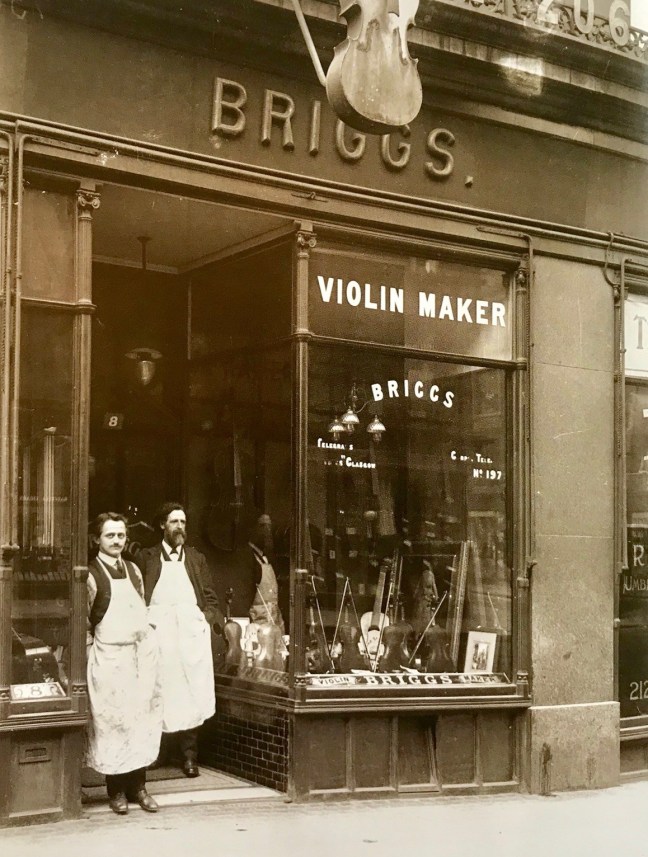
William Brigg’s Sauchiehall Street Shop c 1900, Philip Schreiber (l), William Briggs (r)
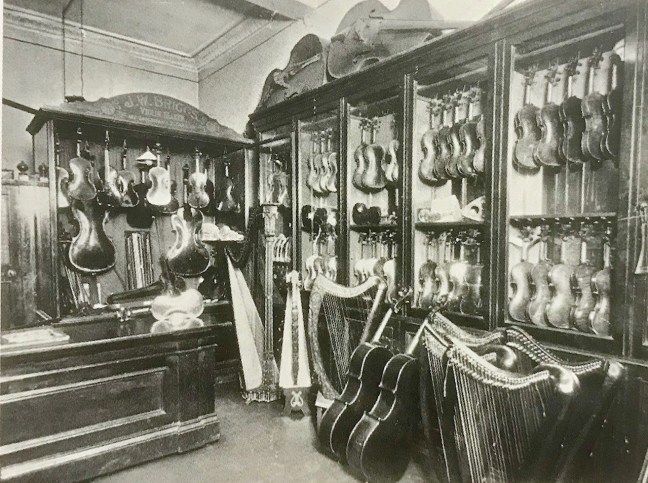
William Brigg’s Shop interior c.1930
His portrait is in the Glasgow Museums Resource Centre , gifted by his son Henry after his death.
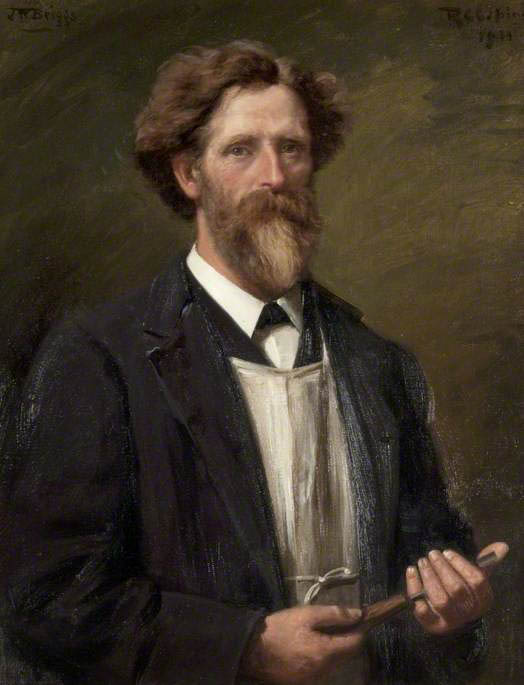
James W. Briggs, Violin Maker in Glasgow by Robert Cree Crawford; Glasgow Museums
He was a
“very fine maker and distinguished connoisseur, unique in being elected to the Violin Maker’s Association of Germany. Employed Philip Schreiber as assistant for over fifty years. Many fine copies of classical instruments with richly-hued varnish of good texture, including an imitation of cellist Pablo Casals’ Gofriller cello. Excellent materials generally, but often with locally sourced pine in the fronts, albeit of fine structure.” (John Dilworth )
A contemporary review by William Meredith Morris reads
“He works at 122 Sauchiehall Street, Glasgow, and was born at Wakefield on July 9, 1855. He received elementary education at the Friends’ School, Rawdon. His father, who is a worthy old Quaker, gave the son a sound grounding in various subjects on commercial lines. Mr. Briggs has supplemented his early training with wide and varied reading in after life. He is a pupil of the late William Tarr, of Manchester, the famous double-bass maker. Up to the end of January 1899 he had made eighty-four violins, eleven violas, eleven ‘cellos, and nine double-basses. All the work is personal, with the exception of the scrolls of the last ten instruments, which have been carved by his son Harry. He works on the Stradivari and Guarneri model, and also on an original one. The measurements of the original model are as follows : —
Length of body … 14 3/16ins,
Width across upper bouts … 6 3/4ins,
Width across middle bouts … 3 7/16ins,
Width across lower bouts … 8 1/4ins,
Length of C’s … 3 1/8ins,
Length of sound-holes … 3 1/16ins,
Depth of lower rib … 1 1/4ins,
Depth of upper rib … 1 3/16ins,
Distance between sound-holes … 1 9/16ins,
The outline is bold and assertive, and moderately pronounced. The scroll, although original, is much in the manner of Joseph (Del Gesu). The button is well designed, but a trifle more circular than that of Strad’s. The corners are full and piquant, and when viewed in conjunction with the widened waist, they give the instrument a breadth of conception. The sound-holes also are original ; they are beautifully cut with a firm hand, and are a sort of compromise between those of Strad and Joseph. The varnish is an oil one, of the maker’s own composition. Colour : golden amber with a rose flush. The tone is strong, bright, and bell-like. When Mr. Briggs works as a copyist, he may be said to be a member of the Vuillaume school, except in the matter of artificially seasoning the wood. His copies of some of the classical violins are, indeed, very fine and correct — too correct, perhaps. It is questionable whether the time spent in copying every little scratch and patch be time profitably spent. A facsimile copy, like that of Mr. Briggs’ Paganini-Joseph, requires immense skill and patience, and it also requires a length of time. To exercise the greatest skill and patience is commendable, but to consume over-much valuable time is against the interests of the art. The fiddle world cannot afford to allow a born artist to dally with scratches and patches. Mr. Briggs had the largest exhibit of instruments at the Glasgow Exhibition, and in many respects the finest. The wood of the backs and ribs was exhibited as timber at the Paris Exhibition of 1880, and also at Vienna in 1890, where it was awarded a gold medal. The bellies were made from wood three hundred years old, taken from an old church in Warsaw, Poland. As an original worker, Mr. Briggs is remarkably free from conventionality, and allows his genius unlimited liberty. At one moment he worships at the shrine of old Antonio, and at the next he is an uncompromising iconoclast. Genius ever was a mystery.” (William Meredith Morris )
His son Henry once claimed wood had also been sourced from Glasgow Cathedral .
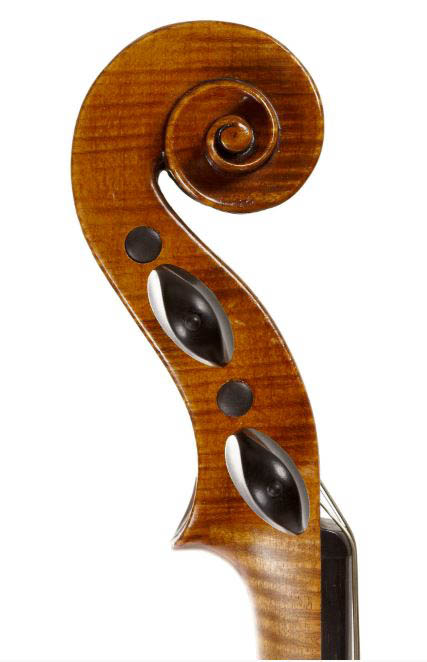
James Briggs Violin
You can hear one of his violins on YouTube , or one of his cellos at Aitchison & Mnatzaganian , who at the time of writing are offering one for sale for a mere £38,000.
In 1932 James was also commissioned to make a replica of the famous 15th century Queen Mary Harp in the National Museums Scotland. James’ copy is now on display in Urquhart Castle . It was his son, Henry, however, who was to become renowned for his harps.
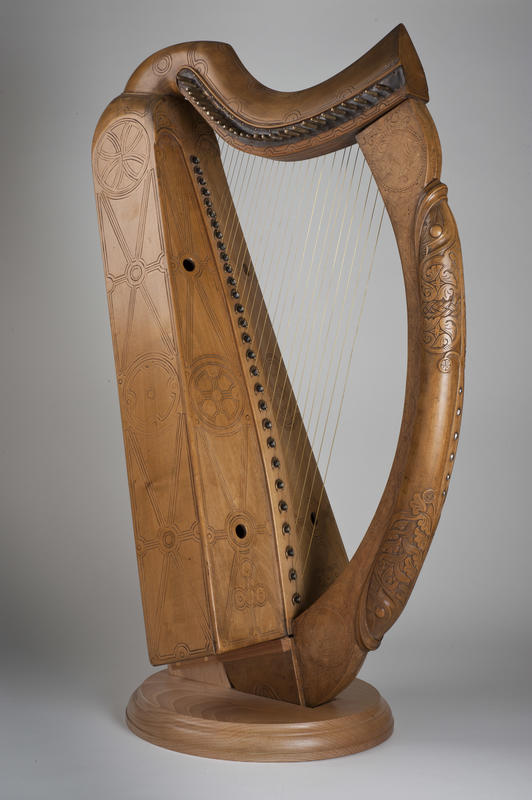
James Briggs’ replica Queen Mary Harp, 1932

Henry Briggs
Henry was born in Wakefield in 1879, and moved with the family to Glasgow in 1893. Henry was sent to Markneukirchen, Germany to learn violin making before returning to his father’s workshop in 1899 to become principal scroll carver. He was never, to my knowledge, a Strathbungo resident and in 1905 was living in Stepps. In 1932 Mrs Duncan MacLeod, of the newly formed Clarsach Society, persuaded Henry to start making clarsachs (celtic harps), as the instrument was at risk of disappearing from Scottish tradition. The music had never been written down by the harpists, and was thought lost during the suppression of Scottish culture after the Jacobite uprisings. He wasn’t keen initially but went on to become known not only for restoring the clarsach into Scottish music, but the harp into Irish music too in the 1950s. He was said to have made over 150 harps. He took over the shop on his father’s death, but later moved to 124 Renfrew Street, taking Philip Schreiber with him. He died in 1963 .

Henry Briggs Dalriada Harp
References
{3557955:YXQN9L7W};{3557955:D2X6ZE4E};{3557955:JLSBYQXL};{3557955:Z5XFZJVX};{3557955:Z5XFZJVX};{3557955:D2X6ZE4E};{3557955:44BK2CGL};{3557955:FFYDHHG5};{3557955:Q3DHFZJP};{3557955:9TJVK5CC}
vancouver
asc
0
1798
%7B%22status%22%3A%22success%22%2C%22updateneeded%22%3Afalse%2C%22instance%22%3A%22zotpress-fb01ebd47d1c5f1ec2ce77312ecfd116%22%2C%22meta%22%3A%7B%22request_last%22%3A0%2C%22request_next%22%3A0%2C%22used_cache%22%3Atrue%7D%2C%22data%22%3A%5B%7B%22key%22%3A%22YXQN9L7W%22%2C%22library%22%3A%7B%22id%22%3A3557955%7D%2C%22meta%22%3A%7B%22numChildren%22%3A1%7D%2C%22bib%22%3A%22%3Cdiv%20class%3D%5C%22csl-bib-body%5C%22%20style%3D%5C%22line-height%3A%201.35%3B%20%5C%22%3E%5Cn%20%20%3Cdiv%20class%3D%5C%22csl-entry%5C%22%20style%3D%5C%22clear%3A%20left%3B%20%5C%22%3E%5Cn%20%20%20%20%3Cdiv%20class%3D%5C%22csl-left-margin%5C%22%20style%3D%5C%22float%3A%20left%3B%20padding-right%3A%200.5em%3B%20text-align%3A%20right%3B%20width%3A%201em%3B%5C%22%3E1.%3C%5C%2Fdiv%3E%3Cdiv%20class%3D%5C%22csl-right-inline%5C%22%20style%3D%5C%22margin%3A%200%20.4em%200%201.5em%3B%5C%22%3EStringers%20of%20London%20%5BInternet%5D.%20%5Bcited%202023%20May%2031%5D.%20Cello%20by%20James%20Briggs%2C%20Glasgow%2C%201927.%20Available%20from%3A%20%3Ca%20href%3D%27https%3A%5C%2F%5C%2Fstringerslondon.com%5C%2Fcellos%5C%2Fp%5C%2Fcello-by-briggs%27%3Ehttps%3A%5C%2F%5C%2Fstringerslondon.com%5C%2Fcellos%5C%2Fp%5C%2Fcello-by-briggs%3C%5C%2Fa%3E%3C%5C%2Fdiv%3E%5Cn%20%20%3C%5C%2Fdiv%3E%5Cn%3C%5C%2Fdiv%3E%22%2C%22data%22%3A%7B%22itemType%22%3A%22webpage%22%2C%22title%22%3A%22Cello%20by%20James%20Briggs%2C%20Glasgow%2C%201927%22%2C%22creators%22%3A%5B%5D%2C%22abstractNote%22%3A%22Excellent%20example%20of%20this%20maker%5Cu2019s%20work%20and%20in%20superb%20condition.%20%20James%20Briggs%20was%20born%20in%20Wakefield%20in%201855%20and%20had%20an%20active%20career%20in%20Glasgow%20from%201893.%20Briggs%20learnt%20his%20craft%20with%20William%20Tarr%20%28Manchester%29.%20He%20was%20awarded%20a%20gold%20medal%20at%20the%20Leeds%20Exhibition%20in%201890%20followed%20by%20multiple%20diplomas%22%2C%22date%22%3A%22%22%2C%22url%22%3A%22https%3A%5C%2F%5C%2Fstringerslondon.com%5C%2Fcellos%5C%2Fp%5C%2Fcello-by-briggs%22%2C%22language%22%3A%22en-GB%22%2C%22collections%22%3A%5B%22CAR6MXPM%22%5D%2C%22dateModified%22%3A%222023-05-31T22%3A15%3A01Z%22%7D%7D%2C%7B%22key%22%3A%22Q3DHFZJP%22%2C%22library%22%3A%7B%22id%22%3A3557955%7D%2C%22meta%22%3A%7B%22numChildren%22%3A1%7D%2C%22bib%22%3A%22%3Cdiv%20class%3D%5C%22csl-bib-body%5C%22%20style%3D%5C%22line-height%3A%201.35%3B%20%5C%22%3E%5Cn%20%20%3Cdiv%20class%3D%5C%22csl-entry%5C%22%20style%3D%5C%22clear%3A%20left%3B%20%5C%22%3E%5Cn%20%20%20%20%3Cdiv%20class%3D%5C%22csl-left-margin%5C%22%20style%3D%5C%22float%3A%20left%3B%20padding-right%3A%200.5em%3B%20text-align%3A%20right%3B%20width%3A%201em%3B%5C%22%3E1.%3C%5C%2Fdiv%3E%3Cdiv%20class%3D%5C%22csl-right-inline%5C%22%20style%3D%5C%22margin%3A%200%20.4em%200%201.5em%3B%5C%22%3ECollections%20%7C%20Historic%20Environment%20Scotland%20%5BInternet%5D.%20%5Bcited%202019%20Jun%2024%5D.%20Queen%20Mary%20Harp%20%5BR%5D.%20Available%20from%3A%20%3Ca%20href%3D%27https%3A%5C%2F%5C%2Fcollections.historicenvironment.scot%5C%2Fobjects%5C%2F20427%27%3Ehttps%3A%5C%2F%5C%2Fcollections.historicenvironment.scot%5C%2Fobjects%5C%2F20427%3C%5C%2Fa%3E%3C%5C%2Fdiv%3E%5Cn%20%20%3C%5C%2Fdiv%3E%5Cn%3C%5C%2Fdiv%3E%22%2C%22data%22%3A%7B%22itemType%22%3A%22webpage%22%2C%22title%22%3A%22Queen%20Mary%20Harp%20%5BR%5D%22%2C%22creators%22%3A%5B%5D%2C%22abstractNote%22%3A%22Historic%20Environment%20Scotland%20cares%20for%20more%20than%2035%2C000%20objects%20at%20160%20properties%20across%20Scotland.%20Explore%20the%20highlights%20of%20the%20collections%20by%20theme%20or%20search%20for%20specific%20objects.%22%2C%22date%22%3A%22%22%2C%22url%22%3A%22https%3A%5C%2F%5C%2Fcollections.historicenvironment.scot%5C%2Fobjects%5C%2F20427%22%2C%22language%22%3A%22en%22%2C%22collections%22%3A%5B%22CAR6MXPM%22%5D%2C%22dateModified%22%3A%222019-06-24T20%3A59%3A11Z%22%7D%7D%2C%7B%22key%22%3A%229TJVK5CC%22%2C%22library%22%3A%7B%22id%22%3A3557955%7D%2C%22meta%22%3A%7B%22creatorSummary%22%3A%22Martin%22%2C%22parsedDate%22%3A%222012-09-25%22%2C%22numChildren%22%3A1%7D%2C%22bib%22%3A%22%3Cdiv%20class%3D%5C%22csl-bib-body%5C%22%20style%3D%5C%22line-height%3A%201.35%3B%20%5C%22%3E%5Cn%20%20%3Cdiv%20class%3D%5C%22csl-entry%5C%22%20style%3D%5C%22clear%3A%20left%3B%20%5C%22%3E%5Cn%20%20%20%20%3Cdiv%20class%3D%5C%22csl-left-margin%5C%22%20style%3D%5C%22float%3A%20left%3B%20padding-right%3A%200.5em%3B%20text-align%3A%20right%3B%20width%3A%201em%3B%5C%22%3E1.%3C%5C%2Fdiv%3E%3Cdiv%20class%3D%5C%22csl-right-inline%5C%22%20style%3D%5C%22margin%3A%200%20.4em%200%201.5em%3B%5C%22%3EMartin%20C.%20scotlandsmusic%3A%20Henry%20Briggs%20-%2020th%20century%20Scottish%20harp%20maker.%20%5BInternet%5D.%20scotlandsmusic.%202012%20%5Bcited%202019%20Jun%2024%5D.%20Available%20from%3A%20%3Ca%20href%3D%27http%3A%5C%2F%5C%2Fscotlandsmusic.blogspot.com%5C%2F2012%5C%2F09%5C%2Fhenry-briggs-20th-century-scottish-harp.html%27%3Ehttp%3A%5C%2F%5C%2Fscotlandsmusic.blogspot.com%5C%2F2012%5C%2F09%5C%2Fhenry-briggs-20th-century-scottish-harp.html%3C%5C%2Fa%3E%3C%5C%2Fdiv%3E%5Cn%20%20%3C%5C%2Fdiv%3E%5Cn%3C%5C%2Fdiv%3E%22%2C%22data%22%3A%7B%22itemType%22%3A%22blogPost%22%2C%22title%22%3A%22scotlandsmusic%3A%20Henry%20Briggs%20-%2020th%20century%20Scottish%20harp%20maker.%22%2C%22creators%22%3A%5B%7B%22creatorType%22%3A%22author%22%2C%22firstName%22%3A%22Christine%22%2C%22lastName%22%3A%22Martin%22%7D%5D%2C%22abstractNote%22%3A%22%22%2C%22blogTitle%22%3A%22scotlandsmusic%22%2C%22date%22%3A%22Tuesday%2C%2025%20September%202012%22%2C%22url%22%3A%22http%3A%5C%2F%5C%2Fscotlandsmusic.blogspot.com%5C%2F2012%5C%2F09%5C%2Fhenry-briggs-20th-century-scottish-harp.html%22%2C%22language%22%3A%22%22%2C%22collections%22%3A%5B%22CAR6MXPM%22%5D%2C%22dateModified%22%3A%222019-06-24T20%3A56%3A41Z%22%7D%7D%2C%7B%22key%22%3A%22D2X6ZE4E%22%2C%22library%22%3A%7B%22id%22%3A3557955%7D%2C%22meta%22%3A%7B%22parsedDate%22%3A%222019-02-28%22%2C%22numChildren%22%3A1%7D%2C%22bib%22%3A%22%3Cdiv%20class%3D%5C%22csl-bib-body%5C%22%20style%3D%5C%22line-height%3A%201.35%3B%20%5C%22%3E%5Cn%20%20%3Cdiv%20class%3D%5C%22csl-entry%5C%22%20style%3D%5C%22clear%3A%20left%3B%20%5C%22%3E%5Cn%20%20%20%20%3Cdiv%20class%3D%5C%22csl-left-margin%5C%22%20style%3D%5C%22float%3A%20left%3B%20padding-right%3A%200.5em%3B%20text-align%3A%20right%3B%20width%3A%201em%3B%5C%22%3E1.%3C%5C%2Fdiv%3E%3Cdiv%20class%3D%5C%22csl-right-inline%5C%22%20style%3D%5C%22margin%3A%200%20.4em%200%201.5em%3B%5C%22%3EWaters%20Violins%20%5BInternet%5D.%202019%20%5Bcited%202019%20Jun%2024%5D.%20Waters%20Violins%20-%20Instrument%20of%20the%20month%20%26%23x2013%3B%20James%20W%20Briggs%2C%201924.%20Available%20from%3A%20%3Ca%20href%3D%27https%3A%5C%2F%5C%2Fwatersviolins.co.uk%5C%2F2019%5C%2F02%5C%2F28%5C%2Finstrument-of-the-month-james-w-briggs-1924%5C%2F%27%3Ehttps%3A%5C%2F%5C%2Fwatersviolins.co.uk%5C%2F2019%5C%2F02%5C%2F28%5C%2Finstrument-of-the-month-james-w-briggs-1924%5C%2F%3C%5C%2Fa%3E%3C%5C%2Fdiv%3E%5Cn%20%20%3C%5C%2Fdiv%3E%5Cn%3C%5C%2Fdiv%3E%22%2C%22data%22%3A%7B%22itemType%22%3A%22webpage%22%2C%22title%22%3A%22Waters%20Violins%20-%20Instrument%20of%20the%20month%20%5Cu2013%20James%20W%20Briggs%2C%201924%22%2C%22creators%22%3A%5B%5D%2C%22abstractNote%22%3A%22This%20month%5Cu2019s%20featured%20instrument%20is%20a%20fine%20Scottish%20violin%20by%20the%20celebrated%20maker%20James%20W%20Briggs%5Cu00a0made%20in%20Glasgow%20and%20dated%201924.James%20Briggs%20was%20a%20maker%2C%20an%20established%20expert%20in%20old%20violins%20who%20r%5Cu2026%22%2C%22date%22%3A%222019-02-28T21%3A09%3A49%2B00%3A00%22%2C%22url%22%3A%22https%3A%5C%2F%5C%2Fwatersviolins.co.uk%5C%2F2019%5C%2F02%5C%2F28%5C%2Finstrument-of-the-month-james-w-briggs-1924%5C%2F%22%2C%22language%22%3A%22en-US%22%2C%22collections%22%3A%5B%22CAR6MXPM%22%5D%2C%22dateModified%22%3A%222019-06-24T20%3A56%3A35Z%22%7D%7D%2C%7B%22key%22%3A%22FFYDHHG5%22%2C%22library%22%3A%7B%22id%22%3A3557955%7D%2C%22meta%22%3A%7B%22numChildren%22%3A1%7D%2C%22bib%22%3A%22%3Cdiv%20class%3D%5C%22csl-bib-body%5C%22%20style%3D%5C%22line-height%3A%201.35%3B%20%5C%22%3E%5Cn%20%20%3Cdiv%20class%3D%5C%22csl-entry%5C%22%20style%3D%5C%22clear%3A%20left%3B%20%5C%22%3E%5Cn%20%20%20%20%3Cdiv%20class%3D%5C%22csl-left-margin%5C%22%20style%3D%5C%22float%3A%20left%3B%20padding-right%3A%200.5em%3B%20text-align%3A%20right%3B%20width%3A%201em%3B%5C%22%3E1.%3C%5C%2Fdiv%3E%3Cdiv%20class%3D%5C%22csl-right-inline%5C%22%20style%3D%5C%22margin%3A%200%20.4em%200%201.5em%3B%5C%22%3EJames%20W%20Briggs%201924%20%5BInternet%5D.%20Aitchison%20%26amp%3B%20Mnatzaganian%20Cello%20Specialists.%20%5Bcited%202018%20Sep%2020%5D.%20Available%20from%3A%20%3Ca%20href%3D%27http%3A%5C%2F%5C%2Fwww.aitchisoncellos.com%5C%2Fantique-cellos%5C%2Fcellos-for-sale%5C%2Fjames-briggs-1924%5C%2F%27%3Ehttp%3A%5C%2F%5C%2Fwww.aitchisoncellos.com%5C%2Fantique-cellos%5C%2Fcellos-for-sale%5C%2Fjames-briggs-1924%5C%2F%3C%5C%2Fa%3E%3C%5C%2Fdiv%3E%5Cn%20%20%3C%5C%2Fdiv%3E%5Cn%3C%5C%2Fdiv%3E%22%2C%22data%22%3A%7B%22itemType%22%3A%22blogPost%22%2C%22title%22%3A%22James%20W%20Briggs%201924%22%2C%22creators%22%3A%5B%5D%2C%22abstractNote%22%3A%22A%20fine%20English%20cello%20by%20James%20W%20Briggs%201924%20for%20sale%20by%20Aitchison%20%26%20Mnatzaganian.%20Previous%20owner%20is%20an%20orchestral%20principal%20and%20soloist%20who%20won%20their%20position%20with%20this%20instrument.%22%2C%22blogTitle%22%3A%22Aitchison%20%26%20Mnatzaganian%20Cello%20Specialists%22%2C%22date%22%3A%22%22%2C%22url%22%3A%22http%3A%5C%2F%5C%2Fwww.aitchisoncellos.com%5C%2Fantique-cellos%5C%2Fcellos-for-sale%5C%2Fjames-briggs-1924%5C%2F%22%2C%22language%22%3A%22en-GB%22%2C%22collections%22%3A%5B%22CAR6MXPM%22%5D%2C%22dateModified%22%3A%222018-09-20T10%3A22%3A46Z%22%7D%7D%2C%7B%22key%22%3A%22JLSBYQXL%22%2C%22library%22%3A%7B%22id%22%3A3557955%7D%2C%22meta%22%3A%7B%22numChildren%22%3A1%7D%2C%22bib%22%3A%22%3Cdiv%20class%3D%5C%22csl-bib-body%5C%22%20style%3D%5C%22line-height%3A%201.35%3B%20%5C%22%3E%5Cn%20%20%3Cdiv%20class%3D%5C%22csl-entry%5C%22%20style%3D%5C%22clear%3A%20left%3B%20%5C%22%3E%5Cn%20%20%20%20%3Cdiv%20class%3D%5C%22csl-left-margin%5C%22%20style%3D%5C%22float%3A%20left%3B%20padding-right%3A%200.5em%3B%20text-align%3A%20right%3B%20width%3A%201em%3B%5C%22%3E1.%3C%5C%2Fdiv%3E%3Cdiv%20class%3D%5C%22csl-right-inline%5C%22%20style%3D%5C%22margin%3A%200%20.4em%200%201.5em%3B%5C%22%3EJames%20W.%20Briggs%2C%20Violin%20Maker%20in%20Glasgow%20%7C%20Art%20UK%20%5BInternet%5D.%20%5Bcited%202018%20Sep%2020%5D.%20Available%20from%3A%20%3Ca%20href%3D%27https%3A%5C%2F%5C%2Fartuk.org%5C%2Fdiscover%5C%2Fartworks%5C%2Fjames-w-briggs-violin-maker-in-glasgow-83639%27%3Ehttps%3A%5C%2F%5C%2Fartuk.org%5C%2Fdiscover%5C%2Fartworks%5C%2Fjames-w-briggs-violin-maker-in-glasgow-83639%3C%5C%2Fa%3E%3C%5C%2Fdiv%3E%5Cn%20%20%3C%5C%2Fdiv%3E%5Cn%3C%5C%2Fdiv%3E%22%2C%22data%22%3A%7B%22itemType%22%3A%22webpage%22%2C%22title%22%3A%22James%20W.%20Briggs%2C%20Violin%20Maker%20in%20Glasgow%20%7C%20Art%20UK%22%2C%22creators%22%3A%5B%5D%2C%22abstractNote%22%3A%22Discover%20artworks%2C%20explore%20venues%20and%20meet%20artists.%20Art%20UK%20is%20the%20online%20home%20for%20every%20public%20collection%20in%20the%20UK.%20Featuring%20over%20200%2C000%20oil%20paintings%20by%20some%2038%2C000%20artists.%22%2C%22date%22%3A%22%22%2C%22url%22%3A%22https%3A%5C%2F%5C%2Fartuk.org%5C%2Fdiscover%5C%2Fartworks%5C%2Fjames-w-briggs-violin-maker-in-glasgow-83639%22%2C%22language%22%3A%22en%22%2C%22collections%22%3A%5B%22CAR6MXPM%22%5D%2C%22dateModified%22%3A%222018-09-20T10%3A17%3A07Z%22%7D%7D%2C%7B%22key%22%3A%22Z5XFZJVX%22%2C%22library%22%3A%7B%22id%22%3A3557955%7D%2C%22meta%22%3A%7B%22numChildren%22%3A1%7D%2C%22bib%22%3A%22%3Cdiv%20class%3D%5C%22csl-bib-body%5C%22%20style%3D%5C%22line-height%3A%201.35%3B%20%5C%22%3E%5Cn%20%20%3Cdiv%20class%3D%5C%22csl-entry%5C%22%20style%3D%5C%22clear%3A%20left%3B%20%5C%22%3E%5Cn%20%20%20%20%3Cdiv%20class%3D%5C%22csl-left-margin%5C%22%20style%3D%5C%22float%3A%20left%3B%20padding-right%3A%200.5em%3B%20text-align%3A%20right%3B%20width%3A%201em%3B%5C%22%3E1.%3C%5C%2Fdiv%3E%3Cdiv%20class%3D%5C%22csl-right-inline%5C%22%20style%3D%5C%22margin%3A%200%20.4em%200%201.5em%3B%5C%22%3EMaker%3A%20James%20Briggs%20%5BInternet%5D.%20Amati.%20%5Bcited%202018%20Sep%2020%5D.%20Available%20from%3A%20%3Ca%20href%3D%27http%3A%5C%2F%5C%2Fwww.amati.com%5C%2Fmaker%5C%2Fbriggs-james-william%27%3Ehttp%3A%5C%2F%5C%2Fwww.amati.com%5C%2Fmaker%5C%2Fbriggs-james-william%3C%5C%2Fa%3E%3C%5C%2Fdiv%3E%5Cn%20%20%3C%5C%2Fdiv%3E%5Cn%3C%5C%2Fdiv%3E%22%2C%22data%22%3A%7B%22itemType%22%3A%22blogPost%22%2C%22title%22%3A%22Maker%3A%20James%20Briggs%22%2C%22creators%22%3A%5B%5D%2C%22abstractNote%22%3A%22Get%20more%20information%20about%20Briggs%2C%20James%20William%20auction%20price%20from%20Amati%27s%20Maker%20Archive%22%2C%22blogTitle%22%3A%22Amati%22%2C%22date%22%3A%22%22%2C%22url%22%3A%22http%3A%5C%2F%5C%2Fwww.amati.com%5C%2Fmaker%5C%2Fbriggs-james-william%22%2C%22language%22%3A%22en%22%2C%22collections%22%3A%5B%22CAR6MXPM%22%5D%2C%22dateModified%22%3A%222018-09-20T10%3A09%3A58Z%22%7D%7D%2C%7B%22key%22%3A%2244BK2CGL%22%2C%22library%22%3A%7B%22id%22%3A3557955%7D%2C%22meta%22%3A%7B%22creatorSummary%22%3A%22Pagabunni%22%2C%22numChildren%22%3A0%7D%2C%22bib%22%3A%22%3Cdiv%20class%3D%5C%22csl-bib-body%5C%22%20style%3D%5C%22line-height%3A%201.35%3B%20%5C%22%3E%5Cn%20%20%3Cdiv%20class%3D%5C%22csl-entry%5C%22%20style%3D%5C%22clear%3A%20left%3B%20%5C%22%3E%5Cn%20%20%20%20%3Cdiv%20class%3D%5C%22csl-left-margin%5C%22%20style%3D%5C%22float%3A%20left%3B%20padding-right%3A%200.5em%3B%20text-align%3A%20right%3B%20width%3A%201em%3B%5C%22%3E1.%3C%5C%2Fdiv%3E%3Cdiv%20class%3D%5C%22csl-right-inline%5C%22%20style%3D%5C%22margin%3A%200%20.4em%200%201.5em%3B%5C%22%3EPagabunni.%20Sound%20Sample%3A%20A%20Scottish%20violin%20by%20James%20Briggs%20%5BInternet%5D.%20%5Bcited%202018%20Sep%2020%5D.%20Available%20from%3A%20%3Ca%20href%3D%27https%3A%5C%2F%5C%2Fwww.youtube.com%5C%2Fwatch%3Fv%3DT0BDNT17uoc%27%3Ehttps%3A%5C%2F%5C%2Fwww.youtube.com%5C%2Fwatch%3Fv%3DT0BDNT17uoc%3C%5C%2Fa%3E%3C%5C%2Fdiv%3E%5Cn%20%20%3C%5C%2Fdiv%3E%5Cn%3C%5C%2Fdiv%3E%22%2C%22data%22%3A%7B%22itemType%22%3A%22videoRecording%22%2C%22title%22%3A%22Sound%20Sample%3A%20A%20Scottish%20violin%20by%20James%20Briggs%22%2C%22creators%22%3A%5B%7B%22creatorType%22%3A%22director%22%2C%22name%22%3A%22Pagabunni%22%7D%5D%2C%22abstractNote%22%3A%22%22%2C%22videoRecordingFormat%22%3A%22%22%2C%22studio%22%3A%22%22%2C%22date%22%3A%22%22%2C%22runningTime%22%3A%22163%20seconds%22%2C%22language%22%3A%22%22%2C%22ISBN%22%3A%22%22%2C%22url%22%3A%22https%3A%5C%2F%5C%2Fwww.youtube.com%5C%2Fwatch%3Fv%3DT0BDNT17uoc%22%2C%22collections%22%3A%5B%22CAR6MXPM%22%5D%2C%22dateModified%22%3A%222018-09-20T09%3A27%3A31Z%22%7D%7D%5D%7D
Like this:
Like Loading...









September 20, 2018 at 4:25 pm
another couple of fascinating posts Andrew. Thanks again for the trouble that you take, always a treat when there is a new post from you.
June 22, 2019 at 8:20 pm
James Briggs was my (adoptive?) great grandfather. I’d really love to know more about his son Henry, who I believe carried on the business. I was given a violin by him when I was ten years old, but it was subsequently lost, alas!
Any information would be wonderful to have.
June 23, 2019 at 11:23 am
That’s all I know, based on internet digging. You could try the Glasgow Resource Centre, given Henry donated the picture. Good to make contact with a descendant!
November 2, 2022 at 10:11 pm
Hello Andrew:
Hope you are well and happy. Look, in my post of June 28, 2019, I made a stupid error. The name of Henry’s daughter was MABEL, not Diana. Mabel had two children, Diana and a son, whose name I don’t recall.
Could you please correct this? As a former newspaper editor, this is painful to me!
Thanks
Pam
(Duly updated – Ed)
August 13, 2023 at 3:18 pm
Hello, Pamela,
My brother found your blog and forwarded it to me. I knew Henry Briggs as Papa Briggs, and have a few memories of him and his house, having spent some time there – I remember the conservatory and his billiard room. My father, Angus Paris was taught by him in violin and clarsach making. I have lived in Canada for over 50 years now and have recently had my 2 violins that my dad made me appraised with a vintner and while at his shop gave him some information on James and Henry. He knew the names, but not much about them, so was very interested in it.
I do hope you will contact me !
June 23, 2019 at 2:34 pm
Although I did find this http://scotlandsmusic.blogspot.com/2012/09/henry-briggs-20th-century-scottish-harp.html?m=1
Claims Henry had a major role in revitalising the clarsach in Scotland and harp in Ireland, when there was no one else who could make them.
June 27, 2019 at 11:25 am
Article updated based on some further research, with thanks to Peter Waters
October 28, 2022 at 11:00 pm
Not sure if you’ll ever be back to read this but I’m the great grandson of his assistant Philip Schreiber (was actually spelt Phillipp but he removed the last “P” as it was less common here).
He’s from a long line of musical instrument makers going back to the 1700s from what we can find. He was a direct descendant of the Hammigs and Hamms from Markneukirchen in Germany (any string intrument creator will know of that place).
He moved to Glasgow (his father, also Philipp Schreiber owned a musical instrument factory in Germany) but when he moved here, and married in 1911, it was impossible for him to start his own business and he was taken to an encampment for Prisoners of War on the Isle of Man (even though he had moved from Germany many years before) – https://www.imuseum.im/search/collections/people/mnh-agent-1282158.html
Hope you find that interesting.
D Schreiber
November 2, 2022 at 9:31 pm
Hello D,
lovely to hear from you and the detail about your great-grandad is familiar to me: in my early teens, possibly at the time of grandad Briggs’ death in the early sixties, my mother told me that he had protested long and loudly about Phillip’s internment.
Did he rejoin the business after the war? I’d love to hear anything at all about these days.
Best wishes,
Thanks very much for contacting me.
Pam
June 28, 2019 at 12:08 am
Thanks, Andrew, good to hear from you. Sorry I didn’t reply as quickly as I would normally, but since I’ve just arrived back in bonny Glasgow after an absence of fifty years, some adjustments had to be made.
I have wonderful memories of summers at Joppa, grandad Briggs enchanting house at Innellan. Fabulous place for kids: trophy rooms filled with stuff from his travels, terrifying geese on the upper pasture, a huge attic filled with old furniture and sea-trunks. There was a large conservatory on the side of the house, where he grew grapes!
Henry was a fine man, quite small, upright in every way, a baptist, so teetotal. Apparently, he suffered a heart attack a few years before he died, and as he lay on the floor in the billiard room(!), someone tried to revive him by pouring a little brandy down his throat. He immediately came round and spat out that devil’s potion.
His daughter Mabel was a ‘dipsomaniac’ as he termed it. Also a colourful character, and I was very fond of her.
She lived there under his supervision, but she often escaped to her favourite watering hole in Dunoon. I saw her once running down the driveway, stark naked, her incredibly long blonde hair streaming behind her, my mother in frantic pursuit. She had an interesting back story, which I won’t go into here.
Henry’s son, my father, was disowned by his father for infractions unknown. He had run away and joined the Royal Navy at 14, where he remained throughout the War, but I’m sure there were other issues.
I loathed my father, he was brutal to his wife and children (four daughters) and blamed my mother for not having sons. Eventually he left in the early sixties, taking up with a woman who had three sons. He completely vanished from our family, and my mother, me and two of my sisters went to Canada in 1966.
I don’t know who inherited that awesome house; probably Mabel’s children, who never associated with junior plebs like us.
April 8, 2024 at 9:31 pm
Pam, my great grandmother was Mabel Briggs making Henry Briggs my great great grandfather. She married a Phillips and had a daughter, Diana, and a son, Peter. Peter Essex Phillips was my father. I lost track of him abruptly in my sophomore year in college after many years of letter writing.
Any further information on the family would be greatly appreciated! My mother lived at Joppa for about two years. My husband and I tried to find the house on a trip to Dunoon several years ago but unfortunately were directed to the wrong house by the local post office.
April 9, 2024 at 4:36 pm
Hello, Deborah,
I assume that you must live in the US … (sophomore year)
I knew Henry Briggs as “Papa Briggs”, and have a few lovely memories of him and his house, having spent some time there – I remember the conservatory and his billiard room. My father, Angus Paris, was taught by him in violin and clarsach making. I have lived in Canada for over 50 years now and have recently had my 2 violins that my dad made me appraised with a vintner, and while at his shop gave him some information on James and Henry. He knew their names, but not much about them, so he was very interested in it and has logged it in his journal on violin makers.
Aileen Ginn
May 14, 2024 at 1:43 pm
Aileen, thank you for sharing this history with me connecting me to my family on my father’s side. My mother shared similar stories of the house and conservatory. It was lovely to hear from you!
May 16, 2024 at 9:08 pm
Hi, Deborah – how lovely to get your response ! Which part of the US are you living in? I’ve been in Ontario, Canada since 1967, a few years after my Dad died, and have only made it back to Scotland twice since then.
January 22, 2020 at 3:39 am
Very interesting information about James William Briggs. I have owned his 37th violin, made in Wakefield in 1888, since I was 10 years old, 53 years. It’s very precious to me and I didn’t play any other violin until recently. Thanks again for the interesting information. I wonder who owned it before me. It was purchased in Carlisle Cumbria.
July 10, 2022 at 3:22 am
I have a violin which was made by James W Briggs in Glasgow, 1905. I have owned it for over 40 years. My parents bought it for me in Sydney, Australia. I don’t know how it came to be for sale in Sydney, but when I tried all the violins in the shop it was the one that sounded the best!
May 30, 2023 at 9:39 pm
Your picture of a James Briggs 1924 ‘cello’ is actually a viola. It has a set of viola strings and an endpin, not a spike, as a cello would have. It is also not on Briggs’ cello model.
May 31, 2023 at 10:17 pm
Thanks, I’m no expert, and the image was provided with the story of the cello, but the page no longer exists. It seems the image is a James Briggs viola. My daughter will be upset, she plays viola. Oops. I’ll edit the text and header image.
May 17, 2024 at 12:52 pm
Hi Aileen, We reside on Long Island, New York. We have visited Scotland 5 times in the past few years. Spent Hogmanay in the Highlands and returned in February for a wedding in Braemar. Would love to get back to Dunoon.
May 17, 2024 at 2:31 pm
How lovely to have been able to visit so many times. I wish I had had the chance when over in 1997 to get to the far highlands to see where my Dad came from, but the furthest north we go was Fort William where we took the ferry over to Mull.
I remember staying over at Papa Briggs’ house on our way to visit Colonsay – I was about 11 or 12 so it’s hard to recall totally, but I do remember playing billiards ! How long have you been in Long Island? We’ve never had the chance to get there, but have traveled through the eastern states a few times – usually on our way to Florida as snowbirds until a few years ago.
May 19, 2024 at 9:04 pm
We’ve been in New York since 1997. Kansas, Colorado & South Carolina prior to that.
We want to visit the Scottish isles on a future trip. So much to see and do!
May 20, 2024 at 12:38 am
You’ve been around the states!! There is so much to see in Bonnie Scotland, I do hope you manage the islands and the highlands too, so much history…